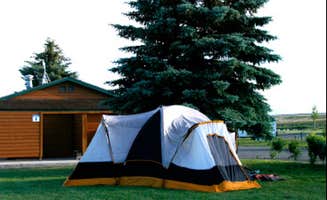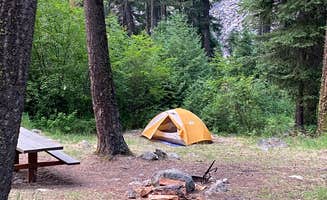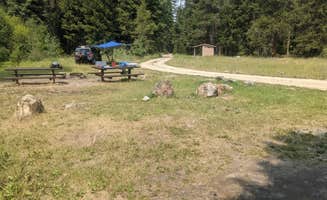Tent camping in the Bitterroot National Forest provides access to over 1.6 million acres of public land spanning the Montana-Idaho border. The region's elevation ranges from 3,200 to 10,000 feet, creating diverse camping environments with temperature variations that can drop below freezing even in summer months at higher elevations. Water access is available at select campgrounds, but many primitive sites require campers to carry their own supply.
What to do
Fishing opportunities: Deep Creek Campground offers crystal clear waters ideal for fishing. A visitor noted, "We fished off the dock and was visited by a large otter!" The creek provides a scenic setting for anglers seeking native trout species.
Wildlife observation: Crazy Creek Campground serves as an excellent base for wildlife viewing. One camper reported, "We had a coyote visit us unexpectedly!" at Crazy Creek Campground. Another visitor mentioned seeing "a doe and fawn on the way out in the morning."
Access to Yellowstone: Some campgrounds serve as convenient staging points for Yellowstone National Park visits. A camper at Crazy Creek noted it provides "quick access to Lamar Valley," making it suitable for day trips into the national park.
What campers like
Water features: The sound of flowing water enhances the camping experience at several sites. At Crazy Creek Campground, a camper appreciated that "the only thing I could hear was the water and later a fire spotter plane overhead." The creek creates a natural sound barrier from other campsites.
Clean facilities: Maintained vault toilets receive positive mentions from visitors. One camper at Crazy Creek noted, "The vault toilet was super clean and serviced recently," indicating regular maintenance even at more remote locations.
Quick access options: For those seeking convenience, Indian Creek Campground provides reliable services close to town. A camper described it as "quick easy and reliable" with "a couple of restaurants within walking distance," making it suitable for travelers needing convenient amenities.
What you should know
Road conditions: Access to many tent camping sites requires travel on unpaved roads. The journey to Deep Creek involves "a long gravel road to get there but worth the trip!" according to one visitor. High-clearance vehicles may be necessary for reaching the more remote camping areas.
Site leveling challenges: Finding flat tent pads can be difficult at some campgrounds. A Crazy Creek visitor reported, "I had site 2 and had to go to a fairly low spot to find a level place to pitch my tent, not a problem during a drought, but it would have been wet if it had rained."
Seasonal smoke conditions: Forest fires in late summer can affect air quality. One camper mentioned, "Maybe it was the smoke from distant fires," indicating that smoke conditions may impact camping experiences during certain periods.
Tips for camping with families
Playground access: Base Camp Campground offers maintained play areas for children. A visitor noted, "Facilities were clean and playground was well maintained," providing structured recreation options for younger campers.
Site proximity considerations: Some campgrounds feature closely spaced sites that work well for group camping. One camper observed Base Camp is "Good for families camping together who want to be close so the littles can play."
Shower availability: Limited shower facilities exist in the region. Indian Creek offers "$4 warm shower" options, which can be important for extended family stays, though the campsite itself was described as "slightly over priced $20 camp site."
Tips from RVers
Noise factors: Highway proximity affects some campgrounds. A visitor to Bitterroot Valley RV Park mentioned it's "right off a very busy highway" and "the traffic noise chased us away early," suggesting tent campers should consider noise levels when selecting sites.
Campground versus RV park distinctions: Some facilities advertised as campgrounds may primarily serve as long-term RV parks. Visitors should verify the nature of the camping area before booking, as facilities may not match expectations based on online descriptions.
Site spacing: RV-oriented campgrounds often have tighter spacing than tent-focused areas. One review noted sites are in "extremely tight proximity to each other," which might not provide the natural separation tent campers typically prefer.




